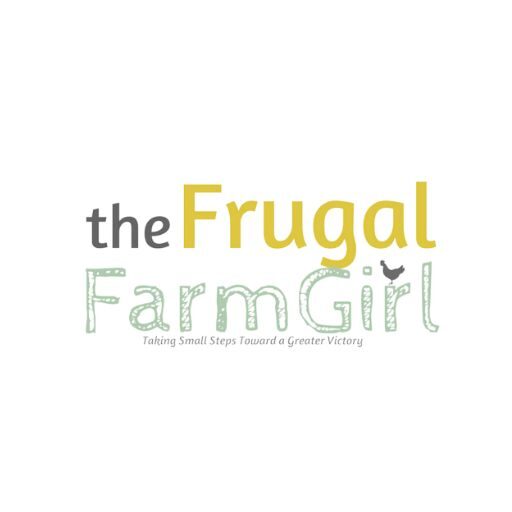If you’ve ever wanted to try growing your own herbs but don’t know where to start, this post is for you! Gardening with herbs can be both fun and rewarding, but it doesn’t have to break the bank.
Whether it’s mint for making mojitos or rosemary for homemade seasonings – there are plenty of delicious ways to use fresh herbs in your meals without incurring costly expenses.
In this blog post, we’ll provide tips on how beginner gardeners can get started growing their herbs at home on a budget.

What Is an Herb?
Before you can start an herb garden, it’s important to have a clear understanding of what an herb is. An herb is any plant with leaves, seeds, or flowers used for flavoring food, medicinal purposes, and fragrances.
Herbs are usually classified into two types: culinary herbs (used in cooking) and medicinal herbs ( used for healing).

Plan Your Garden
You can start by assessing your garden space and the climate you live in. Herbs thrive in sunny, warm locations and require well-drained soil.( More about soil later on in the article) Consider what type of herb you want to grow: some herbs can be grown indoors, while others require outdoor growing conditions.
Make a list of the plants you want to include in your garden and research the best-growing conditions for each herb.
If you want to grow herbs indoors keep in mind how many hours of sunlight is needed for your herbs to grow. When I started, I thought one window would work but quickly realized it didn’t get as much sun as the herb needed.
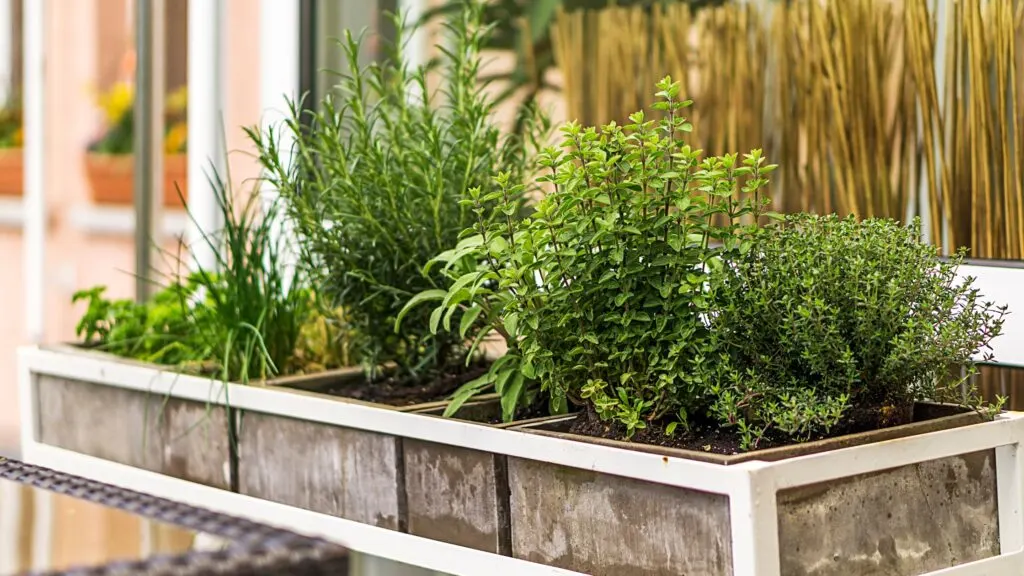
Maximize Your Budget
When it comes to planning and starting an herb garden on a budget, there are a few things you’ll need to consider. Again, decide what kind of herbs you’d like to grow.
Do you want to stick with traditional herbs like basil, thyme, and rosemary? Or would you rather try something a little more exotic, such as lemongrass or lemon verbena?
Keep in mind you want to plant herbs you are most likely to use.
Once you’ve decided on the type of herbs you’d like to grow, it’s time to start budgeting for supplies. Shop for low-cost seeds or plants at local nurseries, dollar stores, or online.
You may even be able to find many herbs for free by asking friends and family if they have any extras or scoping out local plant exchanges.
Check your local library to see if they have a seed exchange program. Our local library has a spot where you can look through all the seeds that have been donated.
Some of the seeds are still in the original packages, while some have come from local gardener’s own backyards.
When choosing herbs, look for kitchen herb starter kits, as these often provide a variety of herb seeds for one low price. I also grab the herb kits that go on clearance at the end of summer. Most of the time, they come with the perfect soil to get the seeds started and a nice pot.
These kits are perfect for the kids to get started with gardening.
Since herb gardens require well-draining soil, choose quality soil designed explicitly for herbs over regular potting soil. If you are going to start with seeds which is the cheapest route, you have to buy seed-starting soil. I explain this in my video below.
Why Plant an Herb Garden?
An herb garden is a great way to add flavor, color, and texture to your garden. Growing herbs can help reduce your grocery bill and provide fresh ingredients for cooking.
Herbs also have numerous health benefits, so having a ready supply of medicinal plants on hand can help you stay healthy all season long!
Plus, herbs are easy to maintain and require minimal care. With a bit of planning, you can create a beautiful and productive herb garden on a budget.
Drying herbs always intimated me, but once I realized how easy it is, I love having herbs on hand from my garden.
Each year I focus on adding one new perennial herb to my garden. I went hard in the beginning and it lead to garden burnout quickly.
If you are new to gardening, you don’t want to get overwhelmed or see all your efforts wasted because it will discourage you from trying again.
Gardening is all about learning and never giving up. Every year will always present new challenges and that is what makes this homesteading life exciting.

Herb Plants Growing Basics
Now that you have your seeds and supplies, it’s time to get planting! Depending on the type of herb, you may need to start them indoors before transplanting outside. When planting herbs outdoors, make sure to dig holes twice as wide as the root ball and provide adequate space for each plant to grow.
Herbs require plenty of water but don’t like to be waterlogged. Water deeply, about once a week or more during dry periods.
Fertilize your herbs lightly with organic fertilizer and mulch around the base of the plants to conserve moisture. Herbs also benefit from regular pruning to encourage new growth and bushier plants—make sure you don’t prune too much at a time!
Don’t forget to research how to harvest and store your herbs. Some herbs need to be dried before you can use them in cooking, while others should be frozen or refrigerated for longer shelf life.
With just a bit of planning, you can create an herb garden that is both budget -friendly and delicious!
- 10 Easy-to-Grow Flowers to Add to Your Potted Plant Collection
- 10 Things You Didn’t Know About Growing Raspberries
- 13 Easy Foods To Grow From Seeds For Cheap
- 13 Perennials You Should Not Cut Back in the Fall
- 16 Best Climbing Flowering Perennials for Your Garden
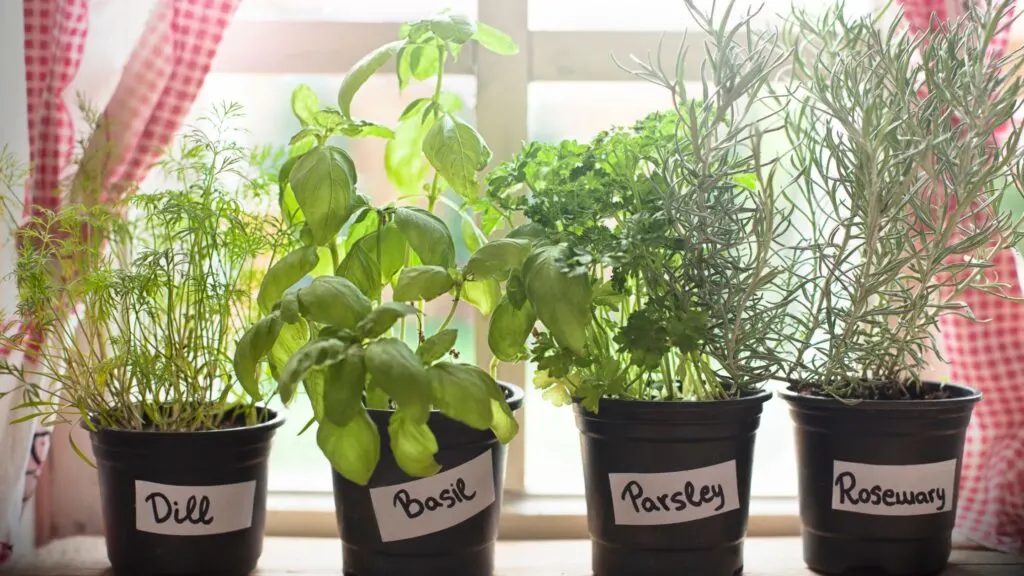
Location
Location, location, location!
When choosing a spot for your herb garden, think sun! To thrive, most herb plants require at least six hours of full sunlight per day. If you’re planting indoors, make sure your herbs are in an area that gets direct light from windows or a skylight.
You can also use plant lights to supplement natural light if needed. Keep in mind this is an additional cost, but it could be worth the initial start-up cost if you live in a region with a short growing season.
Starting annual herbs from seeds in Western New York has always lifted my spirits and helped me get through the winter blues.
It’s important to pick a spot that is sheltered from strong winds, as herbs can be easily damaged by gusts. Herbs generally don’t like competing for nutrients and water, so place them away from other plants to give each one its space.
Finally, make sure you choose an area with well-draining soil for healthy plants.
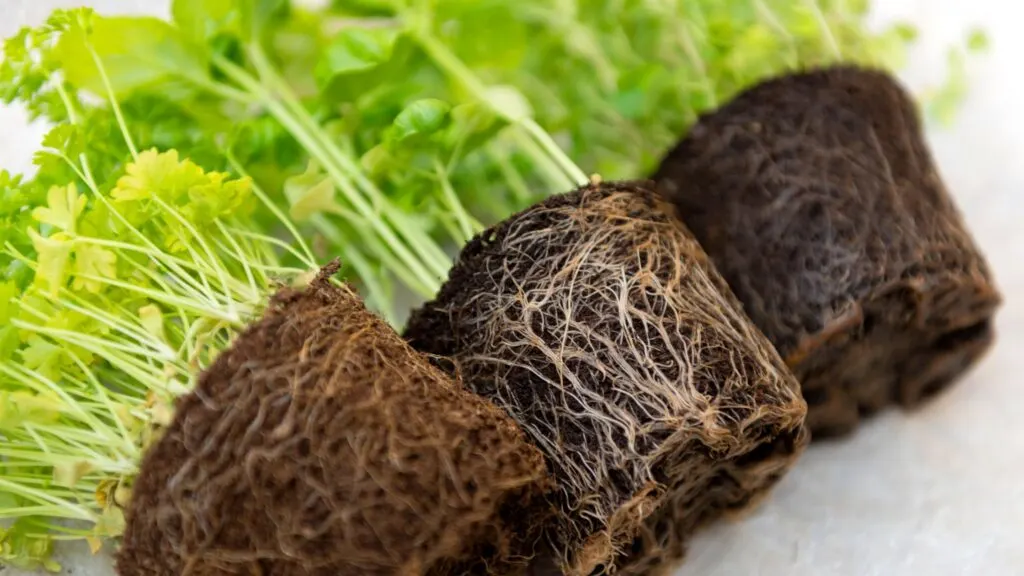
Soil requirements
Herbs like soil that is lightly fertilized and have good drainage. If you’re starting to grow from seed, use a mix of compost, peat moss, and sand to create the perfect conditions for your herbs.
Compost provides plenty of nutrients for your plants, while peat moss helps retain moisture in the soil. The sand keeps the soil loose and prevents drainage problems. In the future, you can end up making your own potting soil for most herbs.
If you’re growing in containers, use lightweight potting soil that has added fertilizer. Make sure your containers have plenty of holes for adequate drainage, and remember to water regularly.
You can start seeds indoors for super cheap; you don’t need fancy equipment. Here are some items you probably have around your home right now you could use to start your seeds.
For more tips on how to Start Container Gardening check out the posts below.
- Why Container Gardening Is The Best Way to Grow Plants
- The Benefits of Container Gardening
- How to Plan Your Container Garden
- How to Choose Plants for Your Container Garden
- How to Choose The Best Containers for Your Garden
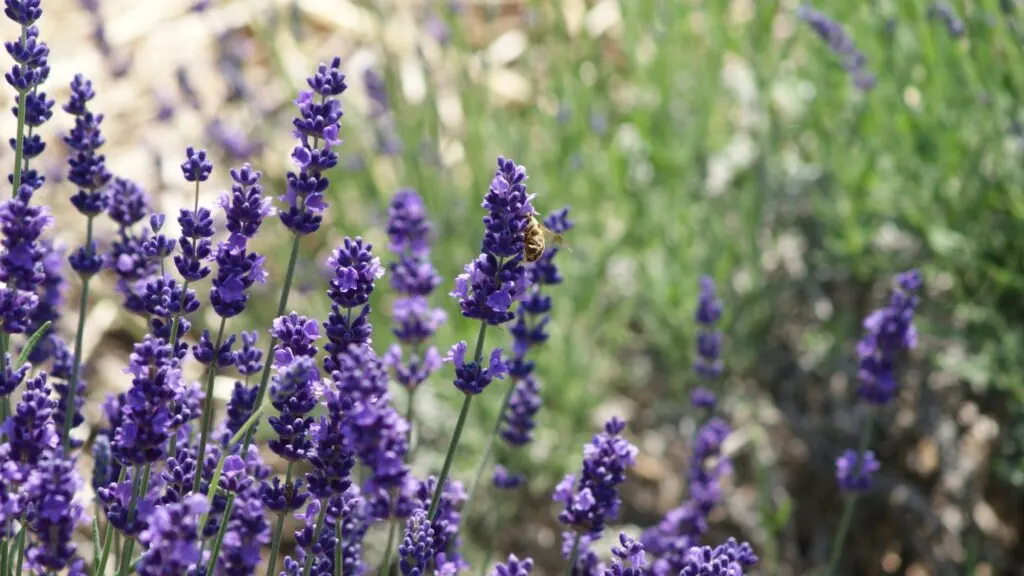
Best Perennial Herbs To Start With
If you want to keep your garden costs down, start with perennial herbs. These plants come back year after year and can be harvested multiple times throughout the season.
My favorite perennial herbs include rosemary, oregano, sage, thyme, lavender, catnip, lemon balm, and chives. I hope to do this year to try marjoram.
These are all some of the easiest herbs to care for and can handle a range of soils, though they do prefer sandy or loamy soil. All these herbs also benefit from full sun or at least 6-8 hours of light each day.
Notice I didn’t have mint on the list. It is a very easy herb to grow and smells amazing BUT take note, it is invasive and will take over your life in just one short year.
I made this mistake when we moved out to our homestead, bought a little chocolate mint plant, and added it to my new perennial garden. Let’s just say after two years, half the perennials were choked out and the others had to be removed. I’ve dug out as much of it as an I can and planted in the goats pen, but it’s still there.
Also, it’s made it’s way over to my neighbor’s garden.
The plus, it smells nice when it’s mowed over. Keep any type of mint in a container or grow it indoors if possible.
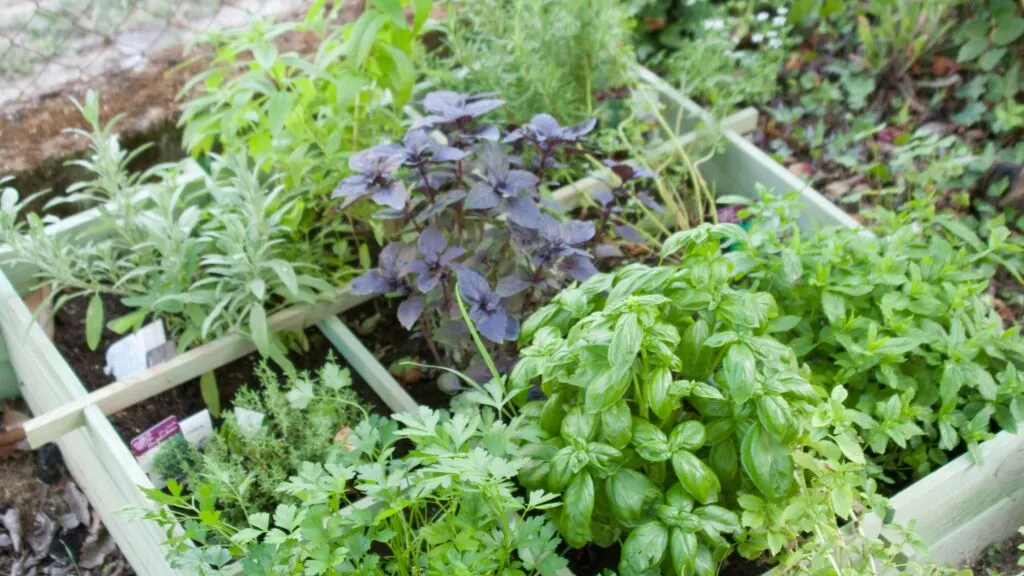
Best Annual Herbs to Start With
If you want to experiment with different herbs, try annuals. These plants need to be replanted every year and can be harvested multiple times throughout the season. Some of my favorite annual herbs include basil, parsley, cilantro, dill, and mint.
Basil was the very first one I started with, and it was easy to remember to use it. We included homemade pizza every Friday on our menu, and in the summer, it’s best to grab basil and tomatoes from the garden.
These herbs all prefer full sun or at least 6-8 hours of light each day and can handle a range of soils, though they do prefer more nutrient-rich soil. Check the plant tags to determine how much water and fertilizer your herbs need.
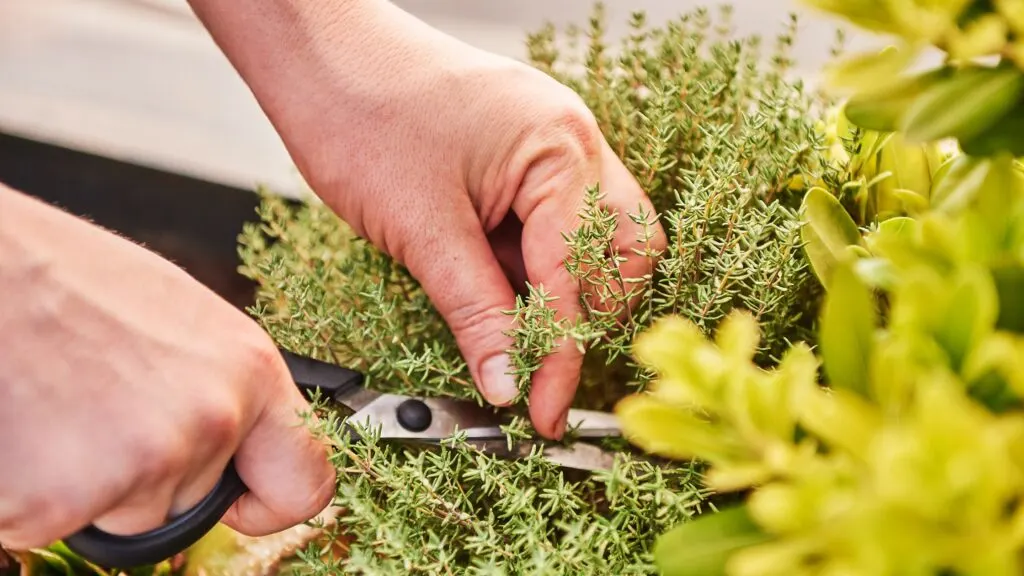
To keep Herbs Going Propagate
Herbs can be propagated easily from cuttings, allowing you to increase your stock for free. To propagate herbs, simply take a stem cutting that is four to six inches long and cut off the lower leaves.
Place the herb in a cup of water in a sunny location. With proper care, your stems should root in two to four weeks. When you see roots you can plant like normal.
Bonus Tip: Use companion planting to maximize your space in the garden. Herbs like marjoram, oregano, and thyme can be planted near vegetables to help repel certain pests.
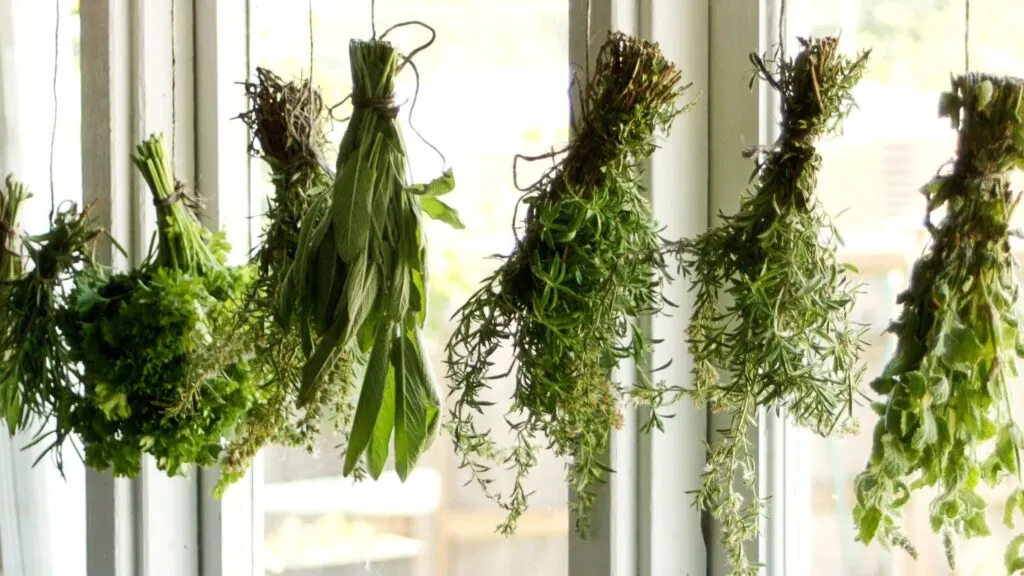
Harvesting Herbs
When it’s time to harvest herbs, be sure to use scissors or a sharp knife and cut the stems at an angle near the base of the herb plant. This will encourage new growth and allow you to harvest more in the future. Also, make sure not to take too many leaves from one plant at a time.
Pinching basil at the tips is an ideal way to gather a small bunch of leaves, while longer stems such as cilantro, parsley and lavender should be snipped close to their base. Leafy perennials like oregano, tarragon and thyme can only be harvested by taking sprigs from the stem for that frugal cost-effective boost!
My favorite herb I love growing and want to grow more is English Lavender. Everything about flowering herbs makes my heart happy. Lavender is a beautiful herb, from the deep purple flowers to the smells and hardiness.
I planted a few bushes near our back deck, and on a windy day, you can smell the lush lavender. I’ll use it in the chicken coop, the nesting boxes, and even the barn. If you aren’t buying herbs from seeds, I find that wholesale clubs like BJ’s and Costco have excellent deals on flowers in the springtime here in NY.
It’s also a cold hardy herb. The flowering tips can be cut and used in vases. I keep the dried flowers all year long in our home too. Can you tell how much I love my lavender? It has so many uses.
My other must-grow herbs are basil, cilantro, parsley, Thyme, and Tarragon. And that’s all you get with those! I love these for cooking purposes the most.
If I had to pick the second-best herb to grow, I’d stick with basil. When you grow Roma tomatoes in your garden and make fresh pasta sauce with fresh herbs, you’ll be sold and never look back to store-bought herbs again.
Top a little basil on your egg and avocado toast, sit back, and smell your lavender. I wish it weren’t the dead of winter right now.
With some planning and some frugal tips and tricks, you can easily plan an herb garden without breaking the bank. Let me know which herbs you are excited to plant or ones you have loved planting for years. Happy planting!
